Something Old, Something New
 Show on map June 25th, 2014
Show on map June 25th, 2014
By Jonathan H

I was back from graduate school and sitting 389 feet above the San Francisco Bay, my feet dangling from historic, 1930s-era steel. I never saw myself a bridge climber, to be honest. Why infiltrate something that you can see every day through the comfort of your vehicle? But this bridge was different. Its destruction was imminent. Nearby, the $6.5 billion eastern span gleamed in LED effulgence, its cables the bar-lines rising to a symphonic crescendo. As a musical score, the new eastern span seemed vaguely ceremonial, its own funeral march for the old, silver, earthquake-prone behemoth sitting next to it.
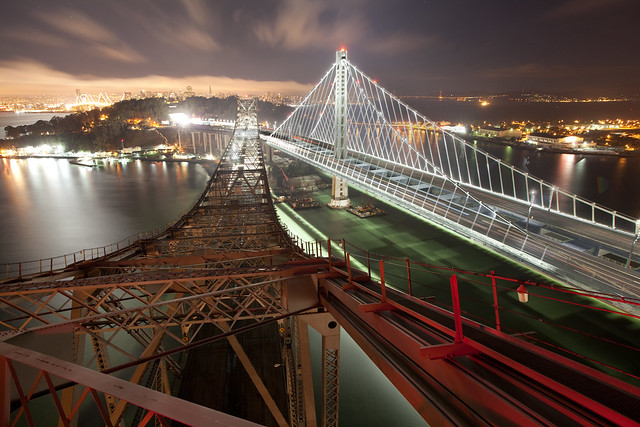
Looking West
If I’m being honest, I should also admit that I found the new bridge underwhelming given its price tag. Maybe it’ll save a lot of lives some day, but its design seemed to have little to do with the history or culture of the San Francisco Bay. The appearance of palm trees along its center divide, a quintessential Southern California symbol perhaps best reflected that.
But I was ready to get back in the groove with old friends. Stephen, who was a critical part of our Mothball Fleet team, was eager to photograph the span before it became inaccessible. The demolition contract was in the works and trucks began occupying the lower deck. Our window of opportunity was short. Because intrepid explorers before us tried – and failed – to visit the bridge without being caught, a highway patrol officer had positioned himself at the most convenient entrance.
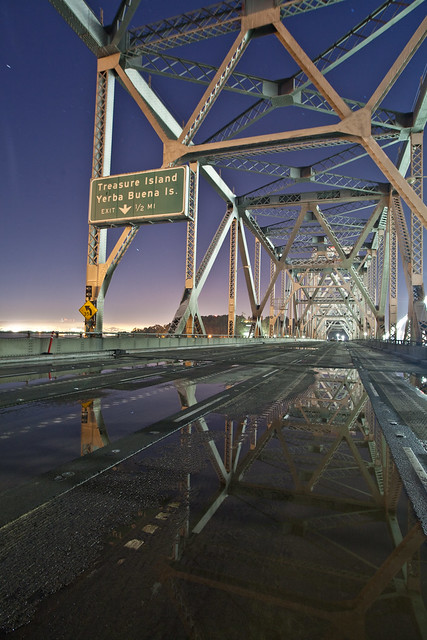
To Treasure Island
Stephen and D, an experienced rock climber, were well into the scoping phase. The two had procured laser distance measurers and determined that the bridge was 191′ off the water. As the bridge approaches Yerba Buena Island, the distance to the precipice is shorter – approximately 130′ and well within the range of an easy escape via abseil if necessary. The bad news: activity at the bridge had picked up. “Two cherry pickers. Several trucks on the span,” D relayed to us. “There is now nighttime activity on the decks and some lighting… One bridge light post was fully-lit on the upper deck and [J] says she saw two more portable lights on the upper deck… Might we have missed the window already?”
Despite these challenges, Stephen, D, and I decided to make a go for it on a clear winter evening. We parked a distance away and began our walk down towards the Art Deco pier dubbed “E1.” Plans call for the pier to remain as an observation deck for the new bridge. The gigantic concrete tower served as a tension tie-down for the cantilever truss. Basically, E1 is holding down – rather than supporting – the truss, which is designed to lift up on its ends.
A glint of full moon arose from Oakland behind the massive Yerba Buena pier. The East Bay crossing is often under-appreciated due to the more dramatic western span suspension portion. Nevertheless, it was a critical piece of what was – at the time – the largest bridge in the world. Only by looking at the bridge in the context of its Depression-era construction can one appreciate the elegant simplicity of its design. It has been heralded as a “marvel of utilitarian efficiency.” Even some of the cranes used in its construction were incorporated as part of the structure. At a cost of $77,000,000 (for the whole bridge, including the eastern and western span), taxpayers in 1934 paid 1/100th what we’re saddled to pay for the eastern span, largely through toll fees.
The East Bay crossing – now half demolished – is comprised of three different basic bridge types .First, closest to Yerba Buena is a series of two cantilever trusses, in the middle of which are 66 feet of pavement and steel. Between the cantilever trusses and the Oakland shore is a series of fourteen deck trusses.Finally, as the bridge makes its descent on to Oakland shore (from a maximum height of 389 feet above sea level), the bridge transitions to girder spans.
The true innovation at the Bay Bridge, however, remains invisible to all – that is, its massive caisson. The chamber was floated into the middle of the channel between Yerba Buena Island and Oakland, then sunk – 242 feet underwater. It remains to this day the world’s deepest bridge pier, and chances are it will remain there, forever, invisible to all.
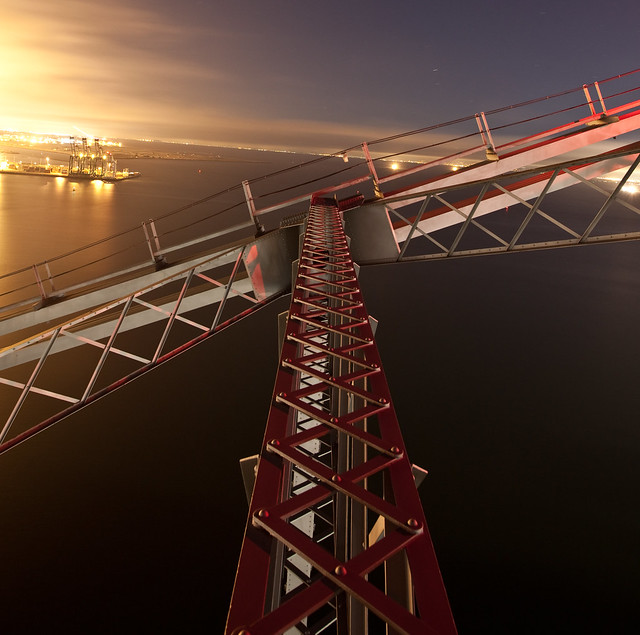
300 Feet High
It was dark, and Stephen knew the best route – a testament to hours of scouting and preparation. We ambled through ivy and blackberry, passing by abandoned Coast Guard facilities along the way (one of which, what appeared to be a large barracks, is now demolished). At the angle of repose, we found ourselves tripping through dense brush and collapsing soil. Erosion netting was our best friend; the thick twine served as foothold as we passed under the new span to reach the footing of the old bridge.
Twenty feet above was the lower deck, now devoid of life save for a lone highway patrol officer facing the oncoming traffic out of the Yerba Buena Tunnel. The immediate challenge involved shimmying up a three-foot gap between the concrete footing of the bridge and one of its steel support columns. The process was easier than it looked. Stephen and I slipped over the Jersey barrier and leaned low to avoid attracting attention. We paused to collect our gear and made a mad dash away with the patrol car to our backs – nothing to hide the officer from seeing us in his rear view mirror.
We passed port-a-potties and piles of corrugated metal along the way. An army of cherry pickers, portable generators, and work lights lined the edge of what was – at one time – devoted to truck and train traffic (until 1958 when the lower deck was converted to general vehicular use). At the time, the lower deck was much too dark to photograph, besides the fact that we both felt exposed should anybody patrol. We knew that the upper deck offered a better long-range view of any incoming security, so we opted to climb one of the few maintenance stairs up to the second level.

Rivets on Old East
Eerie silence. That’s how I would describe the feeling upon emerging on the empty upper deck. It was like emerging from a cocoon. The darkness of the lower deck gave way to bright steel, engineering on display, beauty in design. Fifteen years of driving this deck, and I never imagined walking it alone, at night, devoid of traffic. There it was – the ‘utilitarian efficiency’ waiting to touch and examine, climb and muse over. Rivets followed patterns. Steel had logic. The only thing random in the experience were the scars of 80 years – places where the rubber of tires screeched along the bare asphalt; sites where accidents occurred, where wayward trucks managed to hit the tons of steel only to make negligible dents in its superstructure.
Peering from the upper deck, straight down, was an exhilarating experience. The water took on a radioactive green appearance due to the LED lights projecting from the new span to the north. Like our adventure in Vandenberg, I knew that the side of the bridge would be our only refuge – should a security car approach. There was nothing else to hide behind at that point. I mentioned the possibility to Stephen. Bailing over the edge of the bridge would offer protection from being seen, but we would be entirely subject to our own judgement and footing. Other than steel girders about a foot across, there was nothing to stop our fall 200 feet to the water.
The two of us dropped our gear behind a portable generator light and took swigs of water. As I was sipping, off in the distance, I saw a lone truck approaching us – on the same deck we were on. “Stephen! Somebody’s coming.” We both looked off in disbelief; we expected the lower deck to be patrolled, but not the upper. We had little time to contemplate what to do. The truck would be in our sight within 30 seconds. All we could do was bail over the side. I chose a diagonal column – a thick, steel I-beam that allowed me to lay at an angle. Stephen chose a vertical column – gripping on to the sides of the I-beam with all of his strength so as not to fall in the water below.
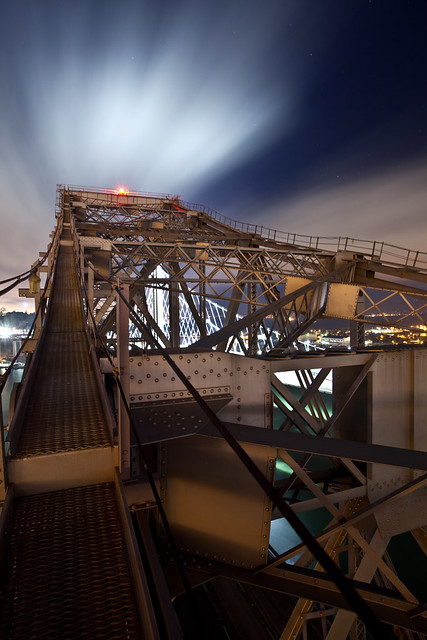
Climbing the Cantilever
In the rush to hide we left our gear behind the portable generator. My camera was standing upright on a tripod. Should security recognize our gear, we would be had. The truck pulled up to the generator light and slowed to a stop. We anxiously anticipated the “Hey! Who’s here?” yell. The man fired up the generator and the upper deck was blanketed in new light. The truck resumed across the bridge to the next light, about 200 yards down. We hopped back on to the deck and contemplated leaving. We agreed to at least to take a few images first. Besides, an exit would be risky, should the truck make a round trip and return. The most prudent option, it seemed, was to climb the cantilever and take images from the top while waiting for the truck to finish its rounds.
Stephen got a call from D, who was supposed to join us later in the evening. “The Highway Patrolman has moved further back. I can’t make it in without being seen.” D would later return with Scott, Stephen, and myself for a final hurrah. But that would have to wait until later – just weeks before the cantilever was unceremoniously cut in half and the dismantled steel transported to the nearest scrapyard.
Then we climbed. Eventually, we found ourselves at the crest of the bridge, 389 feet above the Bay, contemplating all we had accomplished in the past hour. Stephen and I munched on granola, staring out on to the moonlit estuary in the distance. Barges filled with the scrap and detritus of construction stood in the distance. Beyond, the $6.5 million Treasure Island proclaimed the uniquely Bay Area gumption to do things that seem impossible – building islands, pyramids, underwater transit tubes, and bridges to set world records.
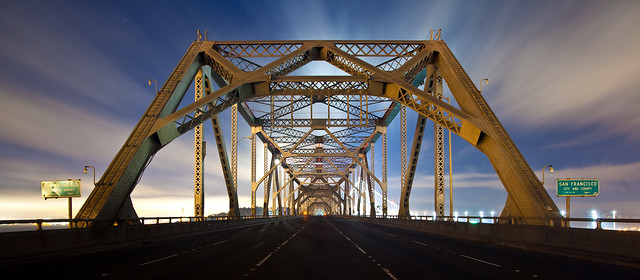
On the Road to San Francisco
Every time I motor across the new $6.5 billion bridge, I see the multitudes of pedestrians and bikers on the Oakland to Treasure Island bike lane. Without fail, they are all staring at one thing – not the gleaming white, single span suspension they’re standing on, but rather the old, grey steel to the South. It seems a shame that we’re losing this Bay Area icon. One wonders why its bones can’t become something new and uniquely Bay Area. The feeling was bittersweet; on the one hand, the solid structure on which we just touched the skies would soon be foggy Bay air. On the other, my return from graduate school marked the beginning of something new and wonderful. As James Joyce once wrote: “Now that the play was over, his nerves cried for some further adventure.”
















